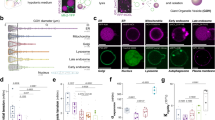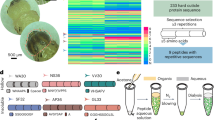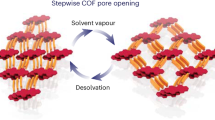Abstract
The remarkable ability of phospholipids to generate vesicles and lamellar morphologies has been mimicked by amphiphilic block copolymers and both classes of amphiphiles have been extensively studied in bulk and in dilute solution. The most common vesicle preparation method involves diffusion of water into a lamellar gel. The transformation proceeds from a collection of water-poor planar lamellae, to a water-rich interconnected layer-phase and then a collection of closed lamellae (vesicles) that form a close-packed gel. This is demonstrated by scattering and microscopy with the evolution of the gel structure being driven by increasing curvature. Vesicles have been observed to form when the copolymer–water system still has long-range order, with a discrete, clustered-vesicle structure leading to a turbid dispersion. Eventually, at very low concentration, the packed vesicles separate, generating very stable isotropic dispersions that are transparent. This phase sequence, involving a dispersion of close-packed vesicles, accounts for the formation of a narrow size distribution in these systems.
This is a preview of subscription content, access via your institution
Access options
Subscribe to this journal
Receive 12 print issues and online access
$259.00 per year
only $21.58 per issue
Buy this article
- Purchase on Springer Link
- Instant access to full article PDF
Prices may be subject to local taxes which are calculated during checkout






Similar content being viewed by others
References
Paschalis, A. & Bjorn, L. Amphiphilic Block Copolymers: Self-Assembly and Applications (Elsevier Science, Amsterdam, 2000).
Hamley, I. W. The Physics of Block Copolymers (Oxford Univ. Press, Oxford, 1998).
Discher, D. E. & Eisenberg, A. Polymer vesicles. Science 297, 967–973 (2002).
Israelachivili, J. N. in Intermolecular & Surface Forces (ed. Press, A.) (Elsevier Science Imprint, London, 2002).
Tanford, C. Hydrophobic Effect: Formation of Micelles and Biological Membranes (Wiley, New York, 1973).
Tanford, C. Interfacial free energy and the hydrophobic effect. Proc. Natl Acad. Sci. USA 76, 4175–4176 (1979).
Israelachvili, J. & Wennerstrom, H. Role of hydration and water structure in biological and colloidal interactions. Nature 379, 219–225 (1996).
Matsen, M. W. & Bates, F. S. Origins of complex self-assembly in block copolymers. Macromolecules 29, 7641–7644 (1996).
Alexandridis, P. & Spontak, R. J. Solvent-regulated ordering in block copolymers. Curr. Opin. Colloid Interface Sci. 4, 130–139 (1999).
Lang, J. C. & Morgan, R. D. Nonionic surfactant mixtures. I. Phase equilibria in C10E4–H2O and closed-loop coexistence. J. Chem. Phys. 73, 5849–5861 (1980).
Tiddy, G. J. T. Surfactant-water liquid crystal phases. Phys. Rep. 57, 1–46 (1980).
Hamley, I. W., Mai, S.-M., Ryan, A. J., Fairclough, J. P. A. & Booth, C. Aqueous mesophases of block copolymers of ethylene oxide and 1,2-butylene oxide. Phys. Chem. Chem. Phys. 3, 2972–2980 (2001).
Wanka, G., Hoffmann, H. & Ulbricht, W. Phase diagrams and aggregation behavior of poly (oxyethy1ene)-poly (oxypropylene)-poly (oxyethylene) triblock copolymers in aqueous solutions. Macromolecules 27, 4145–4159 (1994).
Pople, J. A. et al. Ordered phases in aqueous solutions of diblock oxyethylene/oxybutylene copolymers investigated by simultaneous small-angle x-ray scattering and rheology. Macromolecules 30, 5721–5728 (1997).
Arleth, L., Bergstro, M. & Pedersen, J. S. Small-angle neutron scattering study of the growth behavior, flexibility, and intermicellar interactions of wormlike SDS micelles in NaBr aqueous solutions. Langmuir 18, 5343–5353 (2002).
Bernheim-Groswasser, A., Wachtel, E. & Talmon, Y. Micellar growth, network formation, and criticality in aqueous solutions of the nonionic surfactant C12E5 . Langmuir 16, 4131–4140 (2000).
Kapnistos, M. et al. Reversible thermal gelation in soft spheres. Phys. Rev. Lett. 85, 4072–4075 (2000).
Zilman, A., Tlusty, T. & Safran, S. A. Entropic networks in colloidal, polymeric and amphiphilic systems. J. Phys. C 15, S57–S64 (2003).
Helfrich, W. Lyotropic lamellar phases. J. Phys. C 6, A79–A92 (1994).
Lipowsky, R. The conformation of membranes. Nature 349, 475–481 (1991).
Roux, D., Codon, C. & Cates, M. E. Sponge phases in surfactant solutions. J. Phys. Chem. 96, 4174–4187 (1992).
Granek, R. & Cates, M. E. Sponge phase of surfactant solutions: An unusual dynamic structure factor. Phys. Rev. A 46, 3319–3334 (1992).
Helfrich, W. in Giant Vesicles (ed. Walde, P.) 51–70 (Wiley, Chichester, 2000).
Dobereiner, H.-G., Evans, E., Kraus, M., Seifert, U. & Wortis, M. Mapping vesicle shapes into the phase diagram: A comparison of experiment and theory. Phys. Rev. E 55, 4458–4474 (1997).
Wintz, W., Dobereiner, H.-G. & Seifert, U. Starfish vesicles. Europhys. Lett. 33, 403–408 (1996).
Seifert, U., Berndl, K. & Lipowsky, R. Shape transformations of vesicles: Phase diagram for spontaneous-curvature and bilayer-coupling models. Phys. Rev. A 44, 1182–1202 (1991).
Lasic, D. D., U, R. J., Kellerc, B. C., Frederik, P. M. & Auvray, L. Spontaneous vesiculation. Adv. Colloid Interface Sci. 89–90, 337–349 (2001).
Jain, S. & Bates, F. S. Consequences of nonergodicity in aqueous binary PEO-PB micellar dispersions. Macromolecules 37, 1511–1523 (2004).
Won, Y.-Y., Davis, H. T. & Bates, F. S. Molecular exchange in PEO-PB micelles in water. Macromolecules 36, 953–955 (2003).
Jain, S. & Bates, F. S. On the origins of morphological complexity in block copolymer surfactants. Science 300, 460–464 (2003).
Battaglia, G. & Ryan, A. J. Bilayers and interdigitation in block copolymer vesicles. J. Am. Chem. Soc. 127, 8757–8764 (2005).
Ryan, A. J., Mai, S.-M., Fairclough, J. P. A., Hamley, I. W. & Booth, C. Ordered melts of block copolymers of ethylene oxide and 1,2-butylene oxide. Phys. Chem. Chem. Phys. 3, 2961–2971 (2001).
Lipowsky, R. & Leibler, S. Unbinding transitions of interacting membranes. Phys. Rev. Lett. 56, 2541–2544 (1986).
Leibler, S. & Lipowsky, R. Complete unbinding and quasi-long-range order in lamellar phases. Phys. Rev. B 35, 7004–7009 (1987).
Petrache, H. I. et al. Interbilayer interactions from high-resolution x-ray scattering. Phys. Rev. E 57, 7014–7024 (1998).
Forster, S. et al. Lyotropic phase morphologies of amphiphilic block copolymers. Macromolecules 34, 4610–4623 (2001).
Alexandridis, P., Olsson, U. & Lindman, B. Structural polymorphism of amphiphilic copolymers: Six lyotropic liquid crystalline and two solution phases in a poly(oxybutylene)-b-poly(oxyethylene)-water-xylene system. Langmuir 13, 23–34 (1997).
Rummel, G. et al. Lipidic cubic phases: New matrices for the three-dimensional crystallization of membrane proteins. J. Struct. Biol. 121, 82–91 (1998).
Jamieson, S. J. et al. Projection structure of the photosynthetic reaction centre-antenna complex of Rhodospirillum rubrum at 8.5 Å resolution. EMBO J. 15, 3927–3935 (2002).
Costa, M. F. M. Application of image processing to the characterisation of nanostructures. Rev. Adv. Mater. Sci. 6, 12–20 (2004).
Sokolov, I., Jiang, T. & Ozin, G. A. Tin sulfide mesh: AFM imaging of lamellae and mesopores. Adv. Mater. 10, 942–946 (1998).
Hamley, I. W. et al. From hard spheres to soft spheres: The effect of copolymer composition on the structure of micellar cubic phases formed by diblock copolymers in aqueous solution. Langmuir 2508–2514 (2000).
Glatter, O. & Kratky, O. Small Angle X-ray Scattering (Academic, London, New York, 1982).
Laggner, P. in Small Angle X-ray Scattering (eds Glatter, O. & Kratky, O.) 329–358 (Academic, London, New York, 1982).
Linder, P. & Zemb, T. Neutrons, X-rays and Light: Scattering Methods Applied to Soft Matter (Elsevier Science B.V., Amsterdam, 2002).
Bates, F. S. & Fredrickson, G. H. Block copolymer thermodynamics: Theory and experiment. Annu. Rev. Phys. Chem. 41, 525–557 (1990).
Kroy, K., Cates, M. E. & Poon, W. C. K. Cluster mode-coupling approach to weak gelation in attractive colloids. Phys. Rev. Lett. 92, 148302 (2004).
Bergenholtz, J. & Fuchs, M. Gel transitions in colloidal suspensions. J. Phys. C 11, 10171–10182 (1999).
Haw, M. D., Poon, W. C. K. & Pusey, P. N. Structure and arrangement of clusters in cluster aggregation. Phys. Rev. E 56, 1918–1933 (1997).
Cernik, R. J., Barnes, P., Greaves, G. N., Rayment, T. & Ryan, A. J. Facilities for synchrotron X-ray materials processing on the SRS Daresbury. Appl. Crystallogr. 19, 3–9 (2004).
Acknowledgements
The authors would like to thank the ICI Strategic Technology Group for financial support, and the contribution of S. -M. Mai, who synthesized the block copolymer.
Author information
Authors and Affiliations
Corresponding author
Ethics declarations
Competing interests
The authors declare no competing financial interests.
Rights and permissions
About this article
Cite this article
Battaglia, G., Ryan, A. The evolution of vesicles from bulk lamellar gels. Nature Mater 4, 869–876 (2005). https://doi.org/10.1038/nmat1501
Received:
Accepted:
Published:
Issue Date:
DOI: https://doi.org/10.1038/nmat1501
This article is cited by
-
Tunable and scalable fabrication of block copolymer-based 3D polymorphic artificial cell membrane array
Nature Communications (2022)
-
Evaluation of critical packing parameter in the series of polytyrosine-PEG amphiphilic copolymers
Colloid and Polymer Science (2021)
-
Dynamically arrested micelles in a supercooled sugar urea melt
Communications Chemistry (2018)
-
Self-Assembly of Amphiphilic Block Copolypeptoids – Micelles, Worms and Polymersomes
Scientific Reports (2016)
-
Purification of Nanoparticles by Size and Shape
Scientific Reports (2016)



